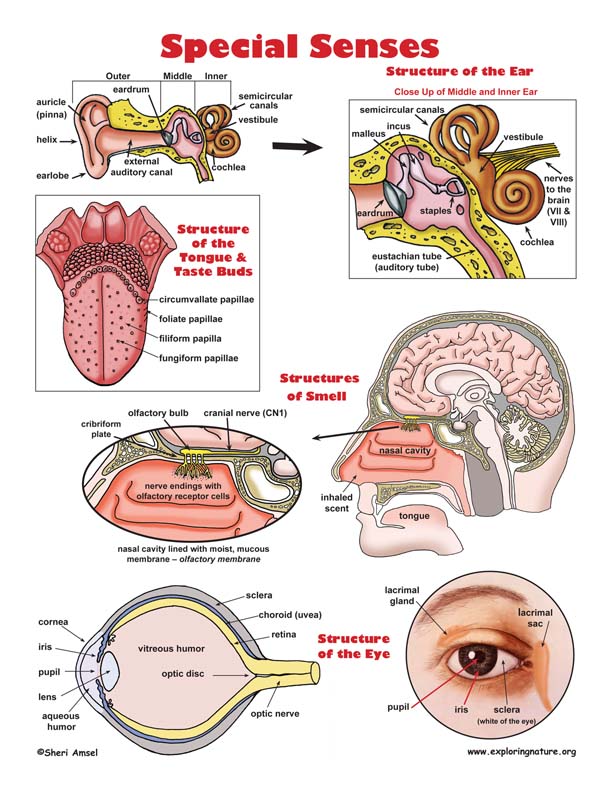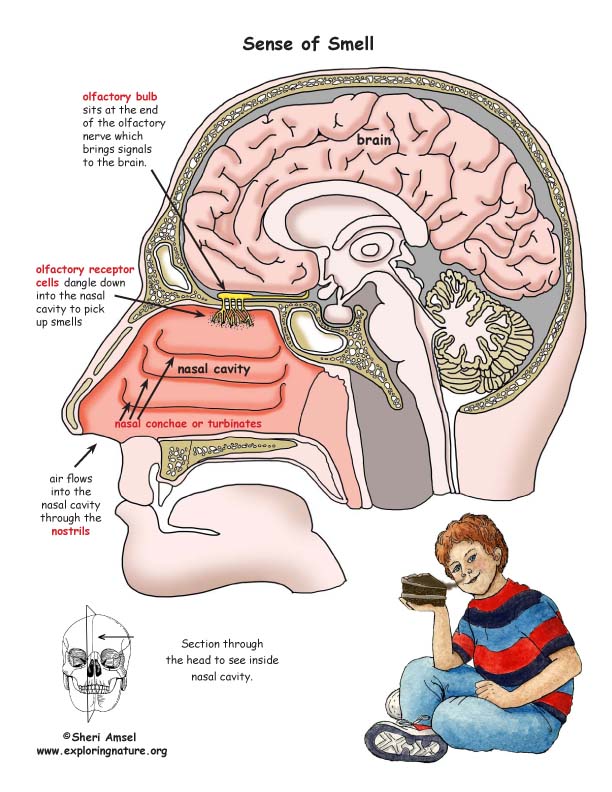

Use Resource Links to Fulfill NGSS
l. Goals:
1. Understand that each sense receptor responds to different inputs (electromagnetic, mechanical, chemical), transmitting them as signals that travel along nerve cells to the brain.Question: What are some examples of electromagnetic, mechanical, chemical sensory stimuli animals recieve and to which they act upon?
1. Break students down into groups of 3-4.
2. Ask students to generate a list of different sensory stimuli (electromagnetic, mechanical, chemical) that animals receive and respond to (i.e. smell, temperature change, etc.)
3. Discuss
lll. New Knowledge about Structure and Function
A. Read about Information Processing
Information Processing - Reading (6-8 Grade NGSS)
Read About Hearing
Read About Sense of Smell
Read About Vision
Read About Taste
Read About Cutaneous Sense Organs
A. Inquiry related to above topics:
Sensory Receptors - Investigation (6-8 Grade NGSS)
Chemoreceptors - Investigation (6-8 Grade NGSS)
B. Examples of Models (depicts the concept expressed in the reading):
Ask students to look at the models and explain how each illustrates the concepts they've read about.
V. Summarize Knowledge - Enduring Understandings
1. Understand that each sense receptor responds to different inputs (electromagnetic, mechanical, chemical), transmitting them as signals that travel along nerve cells to the brain.
Vl. Next Generation of Science Standards (NGSS) - Middle School Life Science
Disciplinary Core Ideas
LS1.D: Information Processing
• Each sense receptor responds to different inputs (electromagnetic, mechanical, chemical), transmitting them as signals that travel along nerve cells to the brain. The signals are then processed in the brain, resulting in immediate behaviors or memories. (MS-LS1-8)
Science and Engineering Practices
Obtaining, Evaluating, and Communicating Information
Obtaining, evaluating, and communicating information in 6-8 builds on K-5 experiences and progresses to evaluating the merit and validity of ideas and methods.
• Gather, read, and synthesize information from multiple appropriate sources and assess the credibility, accuracy, and possible bias of each publication and methods used, and describe how they are supported or not supported by evidence. (MS-LS1-8)
Crosscutting Concepts
Cause and Effect
• Cause and effect relationships may be used to predict phenomena in natural systems. (MS-LS1-8)
• Phenomena may have more than one cause, and some cause and effect relationships in systems can only be described using probability. (MS-LS1-4),(MS-LS1-5)
Performance Expectations Students who demonstrate understanding can:
MS-LS1-8. Gather and synthesize information that sensory receptors respond to stimuli by sending messages to the brain for immediate behavior or storage as memories. [Assessment Boundary: Assessment does not include mechanisms for the transmission of this information.]
When you research information you must cite the reference. Citing for websites is different from citing from books, magazines and periodicals. The style of citing shown here is from the MLA Style Citations (Modern Language Association).
When citing a WEBSITE the general format is as follows.
Author Last Name, First Name(s). "Title: Subtitle of Part of Web Page, if appropriate." Title: Subtitle: Section of Page if appropriate. Sponsoring/Publishing Agency, If Given. Additional significant descriptive information. Date of Electronic Publication or other Date, such as Last Updated. Day Month Year of access < URL >.
Amsel, Sheri. "LS1.D: Information Processing (MS-LS1 From Molecules to Organisms: Structures and Processes)" Exploring Nature Educational Resource ©2005-2024. December 13, 2024
< http://www.exploringnature.org/db/view/Grade-6-8-MS-LS1-From-Molecules-to-Organisms-Structures-and-Processes-LS1D-Information-Processing >



